Choosing a Centerboard or Fixed Keel Sailboat
- Snowboarding
- Scuba Diving & Snorkeling

Centerboard or Fixed Keel?
You need to consider many different questions when deciding what kind of sailboat is best for you .
Depending on the general size range of the sailboats you may be interested in, you may need to choose between fixed-keel boats and centerboard (or swing keel or daggerboard) boats. This article will help you choose which is best for your needs.
As only a very general rule, most sailboats over 20-something feet have fixed keels. Most sailboats under 15 feet or so have centerboards. But there is a wide range of boats from 12 to about 25 feet with either a fixed keel or a centerboard. For example, in this photo, the boat on the left has a fixed keel, while the boat on the right, of about the same size, has a centerboard.
If you are shopping for a sailboat in this range, you should understand the differences between these fundamental types of keels.
Fixed Keel Sailboats
Virtually all large racing and cruising sailboats have a fixed keel. A keel is needed to keep the boat from being blown sideways at all points of sail except downwind. A keel also provides weight low under the water to lower the boat’s center of gravity below the waterline, which is needed so that the boat bobs back upright if knocked over by wind or waves.
Sailboats have many different types of fixed keels , such as full keels (see photo) and fin keels. If you decide a fixed keel boat is best for your sailing purposes, consider also which type keel best meets your needs.
Centerboard Sailboats
On centerboard sailboats, the centerboard functions like a keel to keep the boat from being blown sideways. (All sailboats need a keel of the board for this reason: the narrow, flat surface of the board or keel produces little drag when the boat moves forward but resists motion sideways.)
The centerboard usually hangs down below the hull from a pivot at one end. It can be raised by pulling a line that swings the centerboard up into a centerboard trunk along the center of the boat, as shown in the photo.
Some small boats, like a Sunfish, have a removable daggerboard rather than a centerboard. The daggerboard has the same function, but rather than swinging down, it is inserted like a blade down through a slot in the hull to protrude like a thin keel below the hull. A swing keel is another term used for a type of keel that like a centerboard can be raised.
A centerboard may or may not be weighted. If the centerboard is weighted, then it also provides weight low in the water, like a keel, to help keep the boat upright (although not as much weight as a fixed keel can supply). If the centerboard is not weighted, like the fiberglass centerboards of many small sailboats, then sailors must keep the boat upright by positioning their own weight on the upwind side of the boat.
Benefits and Disadvantages of Fixed Keel and Centerboard Sailboats
Fixed keels and centerboards each have their own benefits but also disadvantages. When deciding what type of boat to buy, be sure you have considered these differences:
Advantages of a Fixed Keel:
- Provides the most ballast to resist capsizing and ensure recovery from a capsize
- More effective at preventing leeway (sideways movement of the boat)
- Crew do not have to position body weight to prevent capsizing (see photo)
- No centerboard moving parts to break or jam
Disadvantages of a Fixed Keel:
- With deeper displacement, the boat cannot enter shallow water
- The boat is heavier for its size (usually an issue only when trailering)
- With deeply fixed keels, the boat may not fit on a trailer at all (25 feet is typically the largest trailerable fixed keel sailboat) - requiring the inconvenience and expense of a boatyard for launching, haulout, and storage
Advantages of a Centerboard:
- The centerboard can be raised to decrease displacement to allow the boat into shallower water – and it should swing up and back if it hits the bottom when sailing with it down
- The centerboard can be raised for faster downwind sailing
- The centerboard can be partially raised if needed to provide better boat balance
- Most centerboard boats can be trailered and easily launched and hauled out on boat ramps (larger centerboard boats may require deeper ramps)
A popular trailerable centerboard sailboat is the MacGregor 26 , which with its water ballast has the advantages of centerboard boats but not all the disadvantages.
Disadvantages of a Centerboard:
- Provides no (unweighted board) or less (weighted board) ballast, compared to a fixed keel, to resist capsizing and ensure recovery from a capsize
- Less effective than a larger fixed keel at preventing leeway (sideways movement of the boat)
- The centerboard trunk takes up space in the boat’s cockpit or cabin
- The centerboard pivot and control line involve moving parts and can jam or break
Finally, some historic crafts have leeboards instead of centerboards; these boards, mounted outside the hull on both sides, can be pivoted down like a centerboard to resist leeward motion. And some sailboats have fixed keel-centerboard combinations, which provide ballast and prevent leeward motion even when the centerboard is up but also provide the option to attain less leeward motion sailing upwind when the board is down.e a centerboard to resist leeward motion. And some sailboats have fixed keel-centerboard combinations, which provide ballast and prevent leeward motion even when the centerboard is up but also provide the option to attain less leeward motion sailing upwind when the board is down.
- Choosing an Inboard or Outboard Engine
- Learn How to Sail a Small Sailboat – 1. The Parts of the Boat
- Buying a Used Boat Online
- Control Your Tiller Without a Tiller-Tamer
- The Types of Sailboat Rudders
- How to Heave To a Sailboat
- Using AIS on Your Sailboat
- How to Anchor a Sailboat
- How to Tow a Dinghy Behind a Sailboat
- The Sunfish: A Perfect Lake or Urban Sailboat
- Tricing Pendants and Lifeboat Rigging
- How to Raise the Mainsail
- How to Gybe a Sailboat
- Best Sailing and Boating Apps
- When to Adjust Sailboat Sails for Stronger Winds
- How to Boat

What’s the deal with Centerboards?
Most of you who have followed our journey for some time are familiar with our somewhat infamous centerboard issue, where we ran aground in the Illinois river in 8′ of water when our boat should only draw 4′ . This was the most dramatic and expensive example of the issues we’ve had with the centerboard thus far, but that’s not to say it’s been the only trouble our centerboard has caused us.
In this week’s video, This Little Thing could SINK our Boat , we’re highlighting another pain point and some of the additional maintenance that comes along with having a pivoting centerboard. We’d like to take this opportunity to talk a little bit about the pros and cons of the centerboard system and shed some light on how we’ve been using it with real life examples.
Sailors love to talk shop. It seems everyone has an opinion when it comes to boats, and if you’re not too careful, it can lead lead to hours upon hours of enjoyable and sometimes educational discussion. Invariably anytime we get beyond the general pleasantries of “She’s a beaut!” or “What’s the length?” we know with more and more certainty that we’re talking with a sailor. As the questions get more specific e.g. “How much fuel do you carry?” or “How tall is the mast?” we will eventually hit this question: “What’s the draft?”
Up until this point, it’s only a Q&A session, but as soon as we divulge the boat has a centerboard — and that with the board up we draw between 4-4.5′ but when it’s down closer to 8′ — the discussion will turn one of three ways:
- The questioner wasn’t quite prepared for that answer and is dumbstruck because they didn’t know as much about boats as they thought they did, and were unaware of the centerboard concept or are unaware a boat of our size could have a centerboard.
- The questioner’s face lights up with a twinkle in their eye and responds with something like: “A perfect Bahamas boat, nice!”
- The questioner’s face scrunches up with terror in their eyes: “Why on god’s green earth would you want to maintain a system like that!”
And after three years of owning, maintaining and traveling aboard a boat with a centerboard, we’ve been in each of these 3 camps at one point or another. Let’s dive in and tackle each point of view.

What is a centerboard on a sailboat?
A centerboard is a retractable appendage that pivots in and out of a slot (centerboard trunk) in the hull/keel of a sailboat. Having the ability to raise and lower the centerboard allows the the boat to operate in shallow waters when lifted, while maintaining good upwind sailing characteristics with the centerboard down. Similarly, lifting the centerboard reduces the wetted surface area, resulting in lower drag while sailing downwind. This combination of characteristics makes it possible to build a safe, seaworthy boat, capable of easily sailing upwind off a lee shore, while still allowing the boat to tuck way up into shallow anchorages when necessary.

When first looking for our sailboat , weren’t specifically looking for a boat with a centerboard. It wasn’t on any “avoid ” list of ours either; it just wasn’t on our radar. So when we first saw the boat online and noticed it had a centerboard, we were pretty ambivalent about it.
Is that like a Swing Keel?
Many people have incorrectly referred to our boat as having a swing keel, and for good reason as they are quite similar on the surface. Before finding our boat, we were aware of other boats with swing keels (specifically Southerly Yachts popularized by “ Distant Shores “) and some of their unique benefits. While the swing keel is similar on the surface, it’s an entirely different animal from our centerboard. They both feature large underwater wing-shaped appendages that pivot from underneath the boat to provide additional wetted surface area to reduce leeway and increase lift for sailing upwind. The main difference is that in a swing keel boat the pivoting appendage is actually the keel. In cruising boats, swing keels weigh several thousand pounds, while centerboards weigh a couple hundred. Thus, a swing keel also contains a large part of the boat’s ballast, so the position of the keel can have a substantial effect on the stability and motion of the boat. Additionally, when retracted all the way up into the hull, the boat can be left to dry out while sitting upright in the sand — pretty cool.

Distant Shores II, a Southerly 480
The flip side is this: In the fully retracted position, the keel needs somewhere to go — which takes up interior volume of the boat. Additionally, moving an extremely large and heavily ballasted keel up and down requires some serious mechanical gear, and unless the swing keel is lowered to some extent, there is nothing counteracting the force of the sails to prevent leeway and the boat will not sail to windward.
Whereas with our boat, in addition to the centerboard, we have a shoal draft keel (which actually doubles as a housing for the centerboard). Even without the centerboard down the boat will still sail to windward. Dropping the centerboard only serves to increase the pointing ability and windward performance. The centerboard does not contribute meaningfully to the ballast of the boat (as it weighs about 200lbs), so its effects on stability in the up or down position are muted. It is designed primarily as a hydrofoil to prevent leeway when sailing upwind and is significantly lighter than its swing keel cousin. Lastly, by retracting into the keel instead of all the way into the hull it does not have any negative effect on the interior volume of the boat.
What are the benefits of having a centerboard on a sailboat?
Besides increased upwind sailing performance, the major benefit of a boat with a centerboard is a shallow draft. For our needs navigating the inland river system, sailing the notoriously shallow Gulf of Mexico , and cruising Bahamaian waters, these are fantastic qualities to have in a boat.
The inland river system has a controlled depth of no less than 9′ in the channel from Chicago to Mobile, Alabama, but most of the channel is significantly deeper than that. However , s earching for marinas and anchorages for the night where you have to exit the channel means the depths start changing quickly. With our shoal draft keel we were able to sneak into a number of marinas with sub 5′ depth at their entrance or at the dock that would’ve been impossible in many other sailboats of our size. Even in Mobile we ran aground twice while moving through the marina to get to our dock.

In the Bahamas we find ourselves anchoring way up towards shore with the catamarans instead of much further out near the monohulls. Yet when it comes time to sail to windward, we’re able to drop the board and point much higher than we otherwise would’ve been able to with the shoal draft keel alone. This can shave miles off long passages and minimizes the number of tacks required in a tight channel.
Additionally, dropping the centerboard just a little bit can give us much better handling in tight quarters, as it prevents the bow from falling off downwind when trying to dock in strong crosswinds.
This all sounds pretty good, right? Why would you not want a boat with a centerboard?
What are the issues with centerboards?
With all the apparent benefits, you’d think the centerboard would be a no-brainer. And if you’re purely concerned with performance, then absolutely, it is. However, the centerboard represents an added layer of complexity that just isn’t absolutely necessary for the operation of the boat. Along with this added complexity comes additional maintenance to ensure the system continues operating normally, and even then, when everything is operating correctly, the maintenance itself can create some stressful situations. Below are a few of the negatives of having a centerboard we’ve discovered so far:
General Maintenance

Our centerboard is raised and lowered via a control line, or centerboard pennant. The line is always underwater inside the centerboard trunk, and is incredibly difficult to inspect. The line exits the boat below the waterline meaning we have an unprotected thru-hull without a seacock to close, should there be a leak. The through-hull is connected to a hose and the hose connects to a conduit in the mast that rises well above the waterline.

The centerboard line runs through this conduit and then exits the mast through a sheave at the deck level. It then runs through a turning block and clutch/winch to lock it off. Each of these items require some level of maintenance and/or at least inspection on a regular basis. These are all fairly simple parts, and the system is quite well-designed. However you can probably already imagine some of the issues…
Stepping & unstepping the mast is more difficult

Because the line runs through the mast, stepping and unstepping the mast requires a few more steps to ensure everything goes smoothly. When unstepping our mast, we need to temporarily slacken the centerboard pennant to allow the mast to be raised out of the boat. To ensure we can run the line back through the mast we need to run a messenger line in the mast to be able to retrieve it again when re-stepping.
When re-stepping the mast, extra care needs to be taken to ensure the mast doesn’t get hung up on the centerboard pennant or the conduit it runs through. We’ve heard of other boats stepping their mast only to realize later that they pinched their centerboard control line.
Naturally (or accidentally) slackening the centerboard pennant allows the centerboard to drop, increasing our draft to 8′, unless it’s secured in some other way. We did this at the start of our river trip by securing a line athwartship from each of the midship cleats to act as a set of suspenders to keep the centerboard pinned up inside the trunk. Unfortunately this wasn’t tight enough and slipped off the centerboard allowing it to drop into the fully-down position. This set us back a few days as we fabricated a much stronger system to secure the centerboard line using an exit sheave at the mast partners.

The centerboard trunk is difficult to clean & paint
While our boat was hauled out, we repainted the bottom with CopperCoat . However we were unable to paint the centerboard or the trunk with the same. Had we known better, we would’ve pulled the centerboard immediately after hoisting the boat out of the water with the travel lift. But since it was our first time hauling the boat for storage, we didn’t realize that once we were moved to the hydraulic trailer which the yard used to position boats, we would not be able to get enough height to drop the board and remove it.

We did hang in the slings over the weekend prior to splashing, which gave us time to get underneath the boat with the board down to clean the centerboard trunk and repaint the board and trunk with ablative bottom paint. But we couldn’t repaint with CopperCoat because of how long it needs to dry before being splashed.
The centerboard pivot point is difficult to inspect

The centerboard pivots on a large stainless steel hinge. This plate is bolted into the keel of the boat and has a large pin that runs through the centerboard allowing it to pivot around this point. There is also a heavy duty stainless eye on the backside of the centerboard that the pennant line connects to. Both of which are always submerged in water, and while they are stainless, stainless corrodes in environments lacking oxygen. So these parts need to be inspected on a regular basis, and this means removal of the entire board, which is easier said than done.

The centerboard can get stuck in the up or down position
The centerboard is designed to pivot up and down in the trunk with fairly small tolerances on either side. Any more space than what is needed to get the board out, and it will interfere with the flow of water over the hull, increasing water resistance and drag. Any extra space will also allow sea life to make its way up into the trunk. Thankfully it’s very dark up in there, there isn’t much water flow carrying nutrients into that space, and we have been diligent about keeping it clean. While we haven’t run into this particular issue yet, we’ve heard of some boats that have had so much growth in the trunk that they can’t get the board to move.
While, we haven’t had our board stuck in the up position, but we have had the board stuck down. The centerboard is a hydrofoil, so the leading edge is a bit wider than the trailing edge, much like an airplane wing. And whereas dagger board trunks (where the board drops in vertically) can be contoured to follow the shape of the board almost exactly, our centerboard trunk is rectangular, as it needs to accomodate the width of the leading edge moving all the way through it. This means the trailing edge of the board (which is on the top when in the retracted position) leaves a lot of extra space between it and the trunk, creating a wedge shape… Maybe you can see where I’m going with this…
A perfect storm scenario can brew under just the right conditions. Imagine for a moment you are loosening the centerboard pennant line to drop the board down, but for one reason or another, the sideways pressure of the water against the board when sailing upwind, growth in the centerboard trunk, stops or slows the dropping motion of board — perhaps it even gets pushed back up slightly as the boat pitches forward and backward in a large wave. You, as the unsuspecting crewman, continue to slacken the line thinking the board is dropping, but in reality what is happening is the line comes to rest on the top of the board, and because of the wedge-shaped trailing edge, the line slips down ever so slightly between the board and the trunk, and gets trapped . Once there it wedges in between the board and the trunk making it extremely difficult to move.
This has happened to us twice. The first was an easy fix, which occurred during a daysail after purchasing the boat. We could’ve easily addressed it without getting into the water, but it was hot, the water was clear, and despite being warned about this particular scenario, I didn’t have a good visualization of what was happening and wanted to see it for myself.

There is actually a built-in mediator of this problem which saved us considerable effort: A short section of exhaust hose with a diameter that almost exactly matches the width of the centerboard trunk serves as a conduit for the last 18″ of line of the centerboard. This prevents the slacked line from getting wedged in too tightly and allowed us to break it free with a tiny bit of force.
The second time however, was much worse, and is covered in detail in Episode 24 . We were in the Illinois Sanitary & Ship Canal, in incredibly disgusting water with no visibility, and because we hadn’t secured the centerboard line properly, the board unbeknownst to us dropped all the way down, and under zero tension actually hung forward of its pivot point. In this position, the geometry for pulling it back up is all out of whack. With the protective hose completely out of the trunk, pulling the control line, only wedging it further in between the trunk and the centerboard.
So is a centerboard actually worth it?
While we’ve been both super happy we have a centerboard and a shallow draft, we have also been exasperated by the extra maintenance, sometimes wishing we had a “normal keel.” But at this point we’ve circled back around to mostly ambivalent. The maintenance while sometimes stressful is all part of owning a boat and the benefit of having a shallow draft when needed are immeasurable.
In reality, we probably only use the centerboard 15-20% of the time we’re actually sailing. If you think about the benefits discussed above, it’s really only necessary in moderate upwind scenarios, which we often avoid anyway. It’s just way more comfortable sailing downwind! We’ve also found in light wind conditions the extra drag created by the centerboard outweighs the pointing ability it generates, so we leave the board up. To top it all off, when we’re not actually sailing (which is most of the time when the boat is at the dock, at anchor, or hauled out for storage) the centerboard is always in the retracted position. For the actual lifespan of the boat, the centerboard is in the down position much less than 10% of the time.
On more than one occasion I’ve thought that I’d rather have a keel full of lead where the centerboard trunk exists now. It would give us added stability 100% of the time, we’d have no additional maintenance, and we’d only miss out on the benefits 10% of the time. However that 10% of the time could potentially make all the difference if we really needed to get off a lee shore. Whenever we are using the board — i.e. upwind especially in a narrow channel or maneuvering under power in tight quarters — we’re often saying to each other “Thank goodness for the centerboard!”
In the end, as with everything on a boat, it’s a trade-off. There’ll always be pros and cons of every design decision. There isn’t one right design for every boat or every boat owner. Overall, we’re happy with our Tartan37c and would not pretend to know more than the S&S design team who dedicated their lives to designing these spectacular boats.
Let us know what you think!
Do you have any experience with a centerboard? Did we miss anything? We’d love your feedback.
This ONE LITTLE THING could SINK our Boat
How to Run Aground in 8’ of Water When You Only Draw 4’
About the Author: Kirk

Related Posts

Building a Sailrite 3-Bow Bimini

Coppercoat as a DIY Project

Is Coppercoat the Best Antifouling for Your Boat?
21 comments.
We had a centerboard on our very first keelboat, a William Tripp designed Polaris 26. Sailing in Michigan on Lake St. Clair, it was a great feature as we could gunk-hole into all kinds of places. Our horror story was that we once forgot we had it down when sailing into a shallow bay and we touched and pivoted under a pretty brisk wind. That was enough to slightly torque and twist the centerboard foil such that it would only retract about 1/3 the way up before getting jammed in the trunk. We had to sail the rest of the season that way until we were hauled out for winter and the yard could bend it back flat. Our subsequent three boats have all been shoal draft versions, which opens up a whole ‘nother discussion of the merits of shoal keel versus deep keel on the same boat model. Fortunately, we switched our home port to Charlevoix 20 years ago, where sailing depths are almost never an issue on Lake Charlevoix/Lake Michigan/Lake Huron. As you said, everything is a compromise with sailboat design. We were glad we had the shoal draft when we delivered our current boat from Annapolis to Charlevoix last year. We draw 6′-6″ and we bottomed out three or four times in the Erie Canal (supposedly a 9′ controlling depth, but who’s counting?). The deep keel version of our boat draws 7′-6″, so we would have never made it back to the Great Lakes. We are eventually going to be bringing this boat back out to the Atlantic permanently when we retire and plan to cruise the Bahamas and the Caribbean, so even the 6’-6″ shoal draft is going to be less than ideal. But hey, if Delos can do it, hopefully we can. Best to you and Lauren.
Jeff W SV Échappé Jeanneau Sun Odyssey 54DS Charlevoix, MI

Thanks Jeff, 6’6″ is the shoal draft?! We were so thankful for our 4’6″ draft in the Abacos. We could anchor in so many great places!
Yeah as usual your videos and blogs are so helpfull to use on my tartan too, you guys are my teachers, when I bought the boat I had the problem with growth inside the trunk, I left the line loose by unexperience and in a sail trip it went down with the shocking waves, I didn’t know it happened and then on another short trip we ran aground because I didn’t know the keel was down. But after that it got cleaned and all works perfect, thanks!!!
Good to hear! Rest assured, if you’ve done it, we probably have as well!
I had many maintenance issues with the centerboard system on my T 37. I managed to drift into shoal water while anchored with the centerboard half down – a position I often used to reduce roll. This resulted in breaking the lower 3/4 of the centerboard off. I recovered it and on next haul out, epoxied it back together and reinstalled it. Next haul out, the SS pivot assembly had a problem in the flange that received the pin – had to be re-fabricated. A couple of years later (I went way too long without a haul out from this point) the bolts holding the pivot assembly became loose and I was unable to lower the centerboard as the pennant was the only thing keeping it in the boat. Sailing with it up didn’t seem problematic.
It all sounds pretty familiar. I think we have a love/hate relationship with ours. 😉
Hello and love your information, site, etc. Your trips are completely unique to me and the blogs and video are welcome adventures. Keep on cruising and writing. Please.
Centerboards: I was raised sailing all manner of boats with them. We had a 48 Alden yawl with a centerboard. I think it went down twice! We cruised Cape Cod, the US East Coast into the Keys, and Bahamas in that boat and all the reasons to have a board were apparent. I was a kid then and wondered why anyone would build a boat without a centerboard.
Then, I started racing and fell in love with deep draft. Our boat now is 32 feet long and draws 6 feet. Oh my, do we go to windward! We have raced a T37 (same handicap) and we out point him but he out foots us and usually finishes ahead. Cruising is not about hours of close hauled sailing. I get it now!
In our harbor and on the next mooring is the referenced T37 that I am coming to love. Pretty boat and shallow draft. Back to my youthful exuberance for a centerboard. If you guys find you way up to the Cape, I hope we see you. Look into Stage Harbor.
Norm Martin Averisera
Hi Norm, thank you for sharing your story. It’s interesting how some boats just reach out and speak to certain people. All the best!
I have a membership in a sailing club with a collection of Capri 22’s that are not all identical. We have weekly races with them, where you show up and draw boat names out of a hat. One of them has a shoal draft keel, it is always the least favorite draw. Typically, while you might be able to point the bow upwind, it’s moving sideways far more than they other boats (regular keel versions of the same boat). But every now and then the wind is just right, and she’ll clean up, just own every race, but this is rare, relies on just right wind (5-10 knots) and tide conditions that allow her to get speed without being pushed leeward. Downwind, she also has a slightly shorter mast (several others also have shorter masts), but still usually keeps up. Possibly an advantage, but not sure. A centerboard would clearly help her upwind in some conditions. But it’s often going to be hard to really see those conditions without head to head comparisons and if your not caring you can just start the engine.
Sounds about right. That shoal draft boat likely does well on downwind legs given there is less surface area under the water.
We’re definitely not the fastest boat to windward, but we’re not racing. There some shoal draft boats that simply can’t sail upwind at all when the wind picks up. They have too much windage and not enough leverage on the water. We will hit hull speed at 30 degrees apparent in 15 knots apparent wind, which I’m quite happy with 🙂 All the best!
A daggerboard is a centerboard, just as one is an integer and a whole number. If the daggerboard is off center it is a leeboard.
Is that so? I always heard it as a centerboard pivots and a daggerboard slides up and down. But I suppose your explanation makes sense!
You guy’s are such centerboard rookies, but then again, most sailors are. I cruise the extremely shallow waters of the Southeast coast of the US and have always sailed centerboard boats for over 40 years, In fact my present boat is a Presto 36, a 18,000 displacement, ketch rigged, true or pure centerboarder, designed in 1884 by Ralph Middleton Munroe. I have no external keel at all, except for a 9″ X 6″X 12′ long lead grounding shoe, designed for “taking the Ground upright”. My draft, board up is 2′-6″ and approx.. 5′-6″ ” board down. The board weights approx. 400 lbs. My centerboard pendant, a 3/8″ super synthetic line runs upwards from the aft end of the centerboard trunk, to the cabin top via 1-1/4″ SS tube and is attached when it exits the top of the cabin, to a simple 6 to 1 tackle to help raise and lower the board. My centerboard trunk runs almost the entire length of the main cabin and has a 2″ dia. hole in it’s aft end. That hole and a short length of broom handle are extremely helpful for for coaxing a resistant board into going down as needed. I have spent many days pleasantly aground on a convenient sand bar, for recreation or maintenance needs and many a night secure in the knowledge, that no matter how busy the surrounding water are, I’m freed from the worries of getting “run” down in the night. Incidentally, I oft use the board along with my mizzen in assisting in self-steering. Never needed any auto-pilot. Up wind, she’s a drag, but any other course, with her sheets eased, she simply can’t be caught..
My wife and I have a Bristol 35.5 with a centerboard. Our installation is much simpler than the one Tartan came up with – I was very surprised when I saw that yours comes up though your mast. Ours is on a wire winch on the cabin house that runs through sealed pipes over sheaves to the board. I’d say that the vast majority of the issues you’ve had with your board are due to that somewhat quirky design. That said, I’ve always loved the look of the Tartan, and you guys have definitely made fantastic improvements.
My wife and I thoroughly enjoy your channel and following your adventures. Keep them coming!
It is a bit of a quirky system, but running it through the mast is kind of a neat way to hide the control line, which needs to enter and exit the hull and deck. It does present some challenges, but it’s neat out of the box thinking. As you know everything on the boat is a tradeoff, and overall we’re extremely happy with the boat. Thank you for watching!
Hi, how confident are you with the centre board in heavy weather … blue water … hove-to? We are going to look at a 47′ sloop with one tomorrow. I love our current smaller steel boat with a full keel but who knows …
Hi Melissa, Tartan 37s have sailed in every ocean on the planet, there have been multiple circumnavigations. As long as we keep the boat properly maintained, I have confidence in it. I don’t know what type of boat you’re looking at or what type of sailing it was designed for, but I don’t think there is anything fundamentally wrong with a centerboard. Good luck!
We have a 79 Irwin 39 with shoal draft an centerboard, the pennant is mid deck and runs through the sole to cabin top” stripper pole” that is attached to the galley and also serves as handhold under way, the pivot is a SS pin that runs abeam and is puttied over, I need to remove this soon as there is a bit more play in this joint than I’m comfortable with, The boat is very tender and we are contemplating the best way to add ballast to the keel as it heels very quickly and carries a lot of sail. The centerboard isn’t very effective when she’s on her ear for limiting leeway losses . She draws 4’3″ up and 9’6″ down, I never thought about partially dropping to improve turning so am excited to try that when maneuvering around docks. I’m hoping adding some lead will make it less tender and will be pursuing this after haulout.

Peter, sounds like you’re at the beginning of a fun adventure learning more about your centerboard and how it can improve the handling of your boat. It was a fun learning journey for us, and we really began to respect the purpose and design of the CB.
I have a 1966 Morgan 34. The bronze centerboard has deteriatiated beyond repair. Especially in the hinge pin and pennant attachment area Draft board up 3 1/2 ft, board down about 7 ft. Bronze board is at least 250 lbs, about 5 ft long, and is a great template
1..Any guidance on where I can get a replacement , perhaps Foss Foam?
2. Is the weight important to proper deployment. Sure cranks hard..a challenge for an old fart to raise
Hi Capt Ron, sorry to hear of your CB woes. Unfortunately I don’t have any sources for replacement. Weight is important, the heavier the better, to an extent. You obviously want to be able to lift/lower it under your own power. At a minimum you need some weight at the bottom of the CB to prevent it from floating and get it to drop down and stay down while underway. But the more weight you can drop down there the better.
Leave A Comment Cancel reply
Save my name, email, and website in this browser for the next time I comment.

My Cruiser Life Magazine
What is a Swing Keel? Advantages & Vs Centerboards, Lifting Keel, Canting Keels
Swing keels are an often misunderstood sailboat feature. They stand unique as a capable offshore sailboat with good windward performance – but they also can provide access to places that few other sailboats can venture.
What is a swing keel, and what makes it so unique? Let’s look at a few examples and weigh the pros and cons.
Table of Contents
Swing keels versus centerboards, swing keel versus lifting keel, swing keels versus canting keels, bilge keels, shoal draft cruisers, daggerboards, advantages of swing keel yachts, disadvantages of swing keels, is a swing keel right for you, faq – questions about swing keel sailboats.
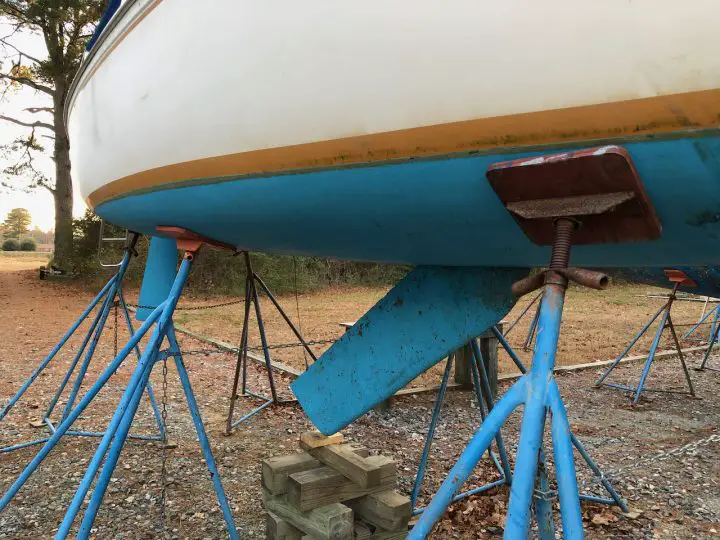
What Exactly are Swing Keels? And What Are They Not?
There’s a lot of misinformation out there about what a “swing keel” is—so let’s start by clearing a few things up. Swing keels are a rare feature found on larger cruising boats. It’s an expensive and specialized item that a boat buyer has to seek out if they want one!
A swing keel is a weighted fin keel that pivots up into the hull of the boat. It can be adjusted from a deep-keel design for optimum sailing performance to a flat-bottomed boat with no keel at all for “drying out” on a sandbar or motoring in extremely shallow water.
In short, a swing keel sailboat gives you the best of all worlds—excellent sailing performance, even upwind, and shallow water access to get in and out of virtually any anchorage or marina in the world.
To be effective, these yachts have very heavy keels. You cannot lift them manually—a proper swing keel requires an electric or hydraulic lifting mechanism. The keel is shaped like an airfoil for maximum performance and is cast out of lead or iron. They usually weigh as much as a couple of automobiles.
Swing keels are effective for two reasons. First, they are ballasted, so they provide righting momentum and stability for the yacht. Secondly, they are shaped like an airfoil, so the water moving over them creates a hydrodynamic force like a regular fin keel does.
There are currently only two major manufacturers of true swing keel yachts— Southerly (now owned by Discovery Shipyards in the UK) and Sirius Yachts from Germany. In 2020, Jeanneau announced a new swing keel version of their Sun Odyssey 410. However, it’s unclear as to precisely what type of keel it features.
The confusion isn’t helped by many sailors using multiple terms interchangeably. The truth is, swing keel sailboats are so rare that most sailors have never even seen one in person! Additionally, some manufacturers use many terms to misdescribe their products as swing keels, adding confusion and taking advantage of the ill-informed.
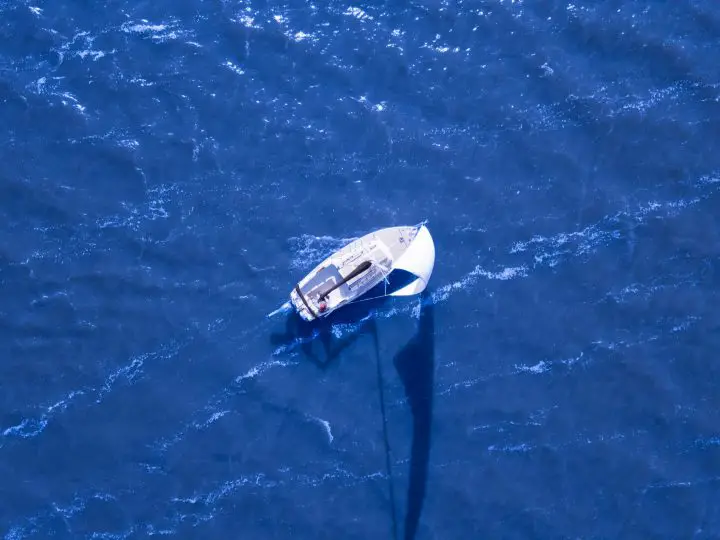
First, and perhaps most importantly, a swing keel is not a centerboard. The two may look similar, but their likeness ends there.
Centerboards are extremely common on small sailboats, especially trailerable sailboats . A centerboard sailboat has a flat bottom and a simple board that pivots back into the hull.
The centerboard itself is usually lightweight and lifted with a simple cable and winch system. More often than not, it’s a flat board made of fiberglass. The effectiveness of a centerboard comes entirely from the pressure of the water moving over it since its light design does not provide any righting momentum of its own.
Some larger and very capable cruising boats do have centerboards. However, these boats are usually fitted with internal ballast to improve the boat’s stability beyond what only the centerboard could provide.
There are many monohull fiberglass boats with centerboards, some of 40 feet or more. Usually, the centerboard option is a less common option from the factory for people who want to use the boat in very shallow water. On bigger boats, the board is usually retracted into a ballasted stub keel that doubles as the centerboard trunk.
The Gemini 105MC Catamaran has a pair of centerboards, each of which can be lifted with its own winch. This setup enables Geminis to operate in shallow waters, even by catamaran standards. The Gemini is a lightly-built coastal cruiser from the US.
Some other interesting examples are the Alubat Ovni and Allures aluminum sailboats made in France. These two companies produce different takes on the rugged “go anywhere” sailboat. To that end, they focus on using a centerboard to reduce the draft to make beaching the boat easy. Both of these boats are capable world cruisers.
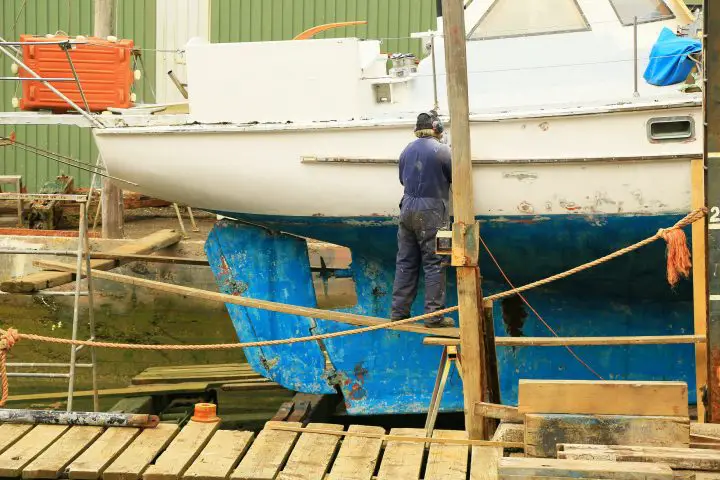
Lifting keels look like a conventional fin, bulb, or even wing keel, but they have one significant design difference. Using a high-power motor, they can lift vertically up into the hull. This allows the yacht to have a conventional ballasted fin keel that adjusts in draft.
With this arrangement, the yacht can squeeze into shallow slips or even shoaly anchorages. But, with the keel fully extended, it has upwind sailing performance similar to a full keel version.
Lifting keels are very rare since the cost of manufacturing the lifting mechanism is so expensive. Plus, the interior of the boat must be designed to accommodate the trunk the keels lift into.
Compared to swing keels, lifting keels are more susceptible to damage from a hard grounding. A swing keel will simply pivot and retract partially. A lifting keel, in contrast, can easily damage the tracks and lifting mechanisms.
Another term that is often batted around is “canting keel.” A canting keel is found only on the most cutting-edge ocean racing boats. They swing not aftward, like a swing keel, but instead side to side.
Why would you ever want your keel to swing to the side? Their purpose is to flatten out the boat when sailing upwind. By getting a flat-hulled racing yacht to sail level, its hull will perform better and overall speed will be increased.
Other Shallow-Draft Designs to Consider
The list above is just a few ways that boat builders have found to reduce the draft of a sailboat. Depending on the purpose, there are other ways to do the job.
Bilge keels boats are most common in the UK. They are sometimes called twin keels because they feature two shorter keels mounted at slight angles below the hull. The main advantage of a bilge keel is that the boat can be allowed to “dry out” in areas of big tidal swings. In other words, the boat can stand on its own after the tide goes out.
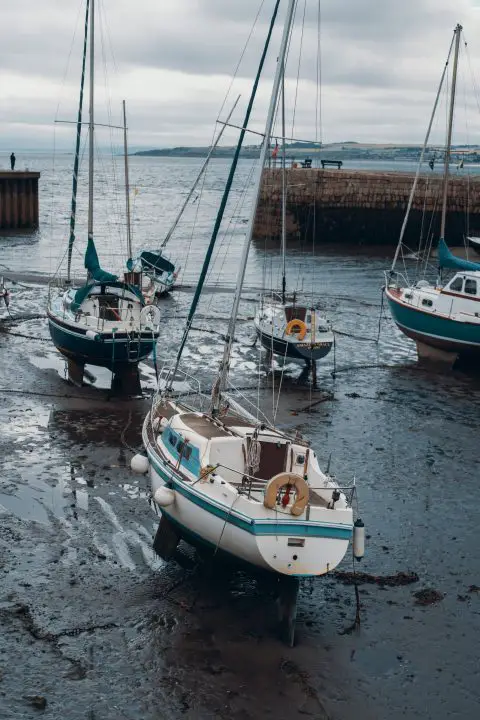
Boat design is all about the give and take. While one buyer might want the ultimate in offshore performance, another might say they want a decent sailing boat that can fit into their slip—which only has four feet of water on the approach. What to do?
If yacht designers were allowed to draw their boats without considering shallow areas, most would attach deep, high-aspect-ratio fin keels. Then the boat would be limited to areas with seven or more feet of water. In some parts of the world, like The Bahamas or the Chesapeake Bay, that limits the number of places they can visit.
So boat builders often make at least two conventional keel versions of a boat. One has the best performance characteristics and a deep draft. The other has a slightly reduced draft and a few design tweaks to make it work. Often, the amount of ballast will be increased to compensate for the change in lateral resistance.
A fixed keel shoal-draft version of a sailboat does have a few advantages over other options. It is just as sturdy as any other keel design and has no moving parts or expensive lifting mechanisms.
Small boats that use centerboards have a few other options. Leeboards are a traditional design that uses pivoting boards mounted on each side of the boat. The classic Herreshoff Meadowlark is a good example.
Daggerboards are similar to centerboards, but instead of pivoting, the boards move directly up and down. Also, like centerboards, the daggers are not ballasted.
This arrangement is used on many sailing dinghies, like the Sunfish. For bigger cruising boats, they are popular on performance cruising catamarans like the Maine Cats, Outreamers, and Catanas.
Simply put, a swing keel yacht will allow you to go places that nothing else will. If you eliminated lightweight centerboard designs from your list of options, there are very few shoal-draft ocean-going sailboats to choose from.
Most centerboard designs are inadequately designed for bluewater sailing. Those built heavier and mounted on larger vessels tend to be mounted in stub keels. While they certainly have a shallower draft than other similar-sized vessels, they are still a far cry from “shoal-draft.” As a result, the list of true bluewater centerboard boats is extremely short.
Swing keels are robustly designed, heavy enough, and stable enough to handle ocean crossings. At the same time, they fold up to access very shallow water. That allows the skipper to get into pretty much any anchorage or marina—even places that other sailboats can’t get into.
There are also times when sailing that the variable draft feature will have its plusses. When sailing downwind, for example, having the keel in the fully lowered position makes little sense. By reducing draft slightly, you might be able to sail fast under spinnaker.
It also enables some swing keel sailboats to be dried out. This is standard practice in some harbors with big tide swings. In other places, it means that you can perform maintenance on a sandbar in the right conditions. And that means fewer trips to the boatyard!
Maybe one of the neatest tricks that will make those with fixed keels jealous is what happens if you run aground in one of these boats. First off, bumps are unlikely to damage the keel. The keel swings on its pivot point. The skipper can then just reduce draft a little, and carefully proceed.

It’s not all good news, of course. If swing keels didn’t have some minuses, chances are there would be a lot more of them out there.
While sailing performance is very good on these boats, it does not match a hull with a full-depth fixed fin keel. The design of the swinging keel does not allow for the same distribution of weight, so the balance of the boat will always be a bit different.
The system required to raise and lower an enormous and heavy keel is not trivial. It is a complex system made up of expensive parts. Experienced boaters will immediately understand the problem with this. It means that it will break one day, and when it does, it will be difficult and expensive to repair.
Routine maintenance is not a burden, however. Beyond checking the hydraulic level, keel threads, and swing keel cables occasionally, there is little to do.
The other significant disadvantage of this system is the initial purchase cost. These boats target a very niche market and only sell a few boats a year. As a result, they’re hard to find, which means that good examples are expensive to purchase. If you’re building a new yacht, then a swing keel system is a costly option.
There are also slight day-to-day considerations with a swing keel. As with any complicated boat system, the keel lifting mechanism will require occasional maintenance. The entire system will likely need to be overhauled by the yard every 20 or 30 years.
Finally, the interior of the yacht must be designed to accommodate the lifted keel. Southerly often solves this by featuring a raised salon area where the central dinette sits higher, on top of the keel enclosure.
While swing keel sailboats are pretty rare, this is no lack of information available about them. The trick is to make sure that the boat you are looking at and talking about is indeed a swing keel and not something else.
Luckily, one of today’s most experienced and knowledgeable cruising couples has several decades of experience on Southerly swing keel sailboats . Paul and Sheryl Shard of the Distant Shores television show have documented their experiences extensively. They have cruised Europe, the Caribbean, and North America and made at least five Atlantic crossings various Southerly sailboats.
Clearly, these boats are not for everyone. Most people don’t need the extra expense or complexity of a swing keel. But if you want a boat that can access shallow water while at the same time not sacrificing offshore or sailing performance, then swing keels should be on your shortlist.
Are swing keels good?
As with all things boating, the answer is, “It depends.” Swing keels are an expensive feature to add to any boat, and as such only well-built boats will bother putting it in.
A swing keel is a good option if you’re looking for a shallow-draft sailboat that does not sacrifice sailing performance. And unlike most centerboard-equipped designs, these boats are bluewater-capable and very robustly built.
Matt has been boating around Florida for over 25 years in everything from small powerboats to large cruising catamarans. He currently lives aboard a 38-foot Cabo Rico sailboat with his wife Lucy and adventure dog Chelsea. Together, they cruise between winters in The Bahamas and summers in the Chesapeake Bay.

What is a Sailboat Centerboard?

A sailboat centerboard is a retractable fin that protrudes from the bottom of the hull. The centerboard keeps the boat stable and on course.
Centerboards are an important and often overlooked part of a sailboat, but they're essential to stability and effective navigation. Centerboards perform the function of a keel and keep the boat on course regardless of wind direction. Centerboards are primarily found on small trailerable vessels, which vary in length from 12 to 25 feet.
Table of contents
How a Centerboard Works
Centerboards look similar to fin keels, but they have one notable difference: they're retractable. Small sailboats use centerboards for stability and to keep a straight course, especially when sailing windward .
Technically speaking, a centerboard is a rudimentary form of a hydrofoil. In practicality, it's like a rudder that always stays amidships. This is beneficial, as it forces the boat to track a straight course regardless of what direction the wind is blowing.
Without the centerboard, the wind would push the sailboat in whatever direction it was blowing. Tacking would be nearly impossible, and attempting to sail windward could simply knock down the boat. In this sense, the centerboard performs the same function as a fixed-keel.
Centerboard Sailboat Characteristics
Centerboard sailboats are typically less than 25 feet in length and designed for shallow water. In fact, centerboard boats are perfect for shallow water. Cruising in lakes and rivers is a joy with a centerboard boat, as the board can be retracted for towing, beaching, or skimming over shallow water. Centerboard sailboats are the ultimate shoal-draft vessels.
Centerboards descend from a hollow cavity in the center of the boat. This cavity is called the centerboard trunk. Some centerboards are removable and slide vertically into the centerboard trunk. Others are hinged or enclosed, allowing them to be raised and lowered from inside the cabin without removal.
Removable Centerboards
Removable centerboards are usually found on the smallest sailboats. These blades tend to be roughly twice the length of how they look from under the boat. This is because the centerboard trunk has to be above the waterline. Remember, the centerboard trunk is effectively a hole in the boat, so it can't be the same height as the water.
Enclosed Centerboards
Enclosed centerboards are common on mid-sized and larger 'small' boats. They're especially common on vessels equipped with cabins. The primary benefit of an enclosed centerboard is water tightness, as the board is housed within a sealed centerboard trunk.
Enclosed centerboards can be raised and lowered from inside the cabin and never needs to be removed from the boat. They're also shorter (overall) than removable centerboards, as they don't mount to the very top of the high centerboard trunk.
The primary drawback of enclosed centerboards is increased complexity and access issues. But in most cases, small centerboard craft are not usually in the water long enough for severe growth issues. Additionally, retracting the board can protect it from excessive marine gunk.
Hinged Centerboards
Hinged centerboards (or 'swing keel' centerboards) are the most common enclosed variety. Hinged centerboards pivot on a forward hinge. They're long and thin and sometimes stow in a hidden centerboard trunk that's mounted to the bottom of the hull.
These 'stealth' centerboard trunks free up cabin space at the expense of a few inches of draft. Hinged centerboards offer an increased level of grounding safety, as they retract on their own if they hit the ground (instead of shearing off). It's the collapsing steering column of sailboat keels .
Advantages of Centerboard Sailboats
The primary advantage of a centerboard boat is its inherent shoal-draft capability. That means centerboard boats can go a lot closer to shore than fixed-keel vessels. They can even go on shore, and drying out during low tide is rarely hazardous. They sit upright on dry land, and they're easy to trailer around.
The cost to construct, own, and maintain a centerboard cruiser is often far less than a traditional fixed- keel sailboat . This is primarily because you usually don't need a crane to pull it out of the water. Centerboard boats are often small and light enough to leave on a trailer, and their small size avoids excessive marina fees.
Disadvantages of Centerboard Sailboats
Can you cross an ocean in a centerboard sailboat? Most would caution against it. Some would say, "absolutely not," but it has happened a time or two. The issues with centerboard sailboats are size, displacement, draft, and stability, which cause problems in rough weather.
Most centerboard sailboats are only comfortable in calm coastal and inland waters. Conditions aboard a shoal-draft sailboat in foul weather range from uncomfortable to downright perilous, which is a major tradeoff. Additionally, small centerboard sailboats typically lack the cabin and storage space necessary for seagoing provisions.
Also, most small centerboard sailboats simply aren't designed for extended cruising. Things like generators, VHF radios, large freshwater tanks, and bathroom facilities usually aren't up to the task on small boats.
Centerboard Sailboat Propulsion
The smallest centerboard sailboats, such as Sunfish and Laser racers, have no propulsion system other than the sail itself. However, anything beyond 15 feet in length will probably have some alternative propulsion. Small boats have an oar or two on board, but most utilize a 5 to 10-horsepower outboard motor.
Inboard motors are rare, but a one or two-cylinder marine diesel can sometimes be found below the cockpit of a centerboard cruiser. Some small 'motor-sailer' boats have inboard engines and a centerboard for sailing.
Best Centerboard Sailboats for Cruising
Centerboard sailboats are ideal for coastal and inland cruising, and many of these pocket-sized vessels include surprisingly comfortable accommodations. These aren't dinghies or converted rowboats; they're serious sailing vessels in a compact package. Here are a few of the best 'all-around' centerboard sailboats available today.
Catalina 22
The Catalina 22 is one of the most popular sailboats ever built. It has the profile of its larger cousins (like the Catalina 27) but features a compact swing keel centerboard instead of a fin keel . At 22 feet long, the Catalina 22 is about as hardy as centerboard cruisers get.
And thanks to its retractable hinged centerboard, there's enough cabin space for a V-berth, porta-potty, stove, sink, settee, and a convertible dining area berth. The trailerable Catalina 22 is widely available on the used market, often for entry-level pricing.
West Wight Potter 19
The West Wight Potter 19 is a small centerboard pocket cruiser with a cult following. It's a fiberglass V-bottom trailer sailboat with a spacious cabin, retractable centerboard, and foldable mast. This little cruiser is capable and convenient, and it's still produced today.
West Wight Potter sailboats are famous for being (quite literally) unsinkable. They're loaded with flotation foam and stay afloat even when completely flooded. Plus, they're easy to sail, and they have an enormous amount of natural stability.
The Hunter 22 is a remarkably well-balanced centerboard cruising boat. Like the Catalina 22, this Hunter sailboat features a compact swing-type retractable centerboard. It has a spacious cabin with room to accommodate the whole family on short voyages.
Hunter designed this compact cruising sloop with a masthead rig, which is simple to operate and robust. These vessels were only produced for a few years in the 80s, but variants are plentiful, and they're plenty of fun to sail.
Centerboard Vs. Fixed Keel
Are you interested in buying a sailboat ? Deciding between a centerboard and a fixed keel is an important decision that shouldn't be overlooked. If you're looking for a trailerable weekender for short voyages and an occasional offshore run, then consider a centerboard. They're cheap and easy to store in or out of the water.
Centerboard sailboats are also ideal for island hopping, as long as the islands aren't too far from your homeport. Florida to the Bahamas is a common and manageable journey for cruising centerboard boats.
And since centerboard sailboats tend to be smaller, it's important to consider how much provision storage you'll need for the journey. Running out of food or fresh water isn't much fun in the middle of the ocean.
Fixed keelboats are ideal for extended offshore voyages and coastal cruising, especially in choppy waters. A fixed keel cruising boat offers superior roll comfort, stability, and handling in a wide range of weather conditions. They're safer in storms as well. For serious sailing, it's difficult to find an ideal alternative.
Related Articles
Daniel Wade
I've personally had thousands of questions about sailing and sailboats over the years. As I learn and experience sailing, and the community, I share the answers that work and make sense to me, here on Life of Sailing.
by this author
Sailboat Parts
Learn About Sailboats
Most Recent

What Does "Sailing By The Lee" Mean?
October 3, 2023

The Best Sailing Schools And Programs: Reviews & Ratings
September 26, 2023
Important Legal Info
Lifeofsailing.com is a participant in the Amazon Services LLC Associates Program, an affiliate advertising program designed to provide a means for sites to earn advertising fees by advertising and linking to Amazon. This site also participates in other affiliate programs and is compensated for referring traffic and business to these companies.
Similar Posts

Affordable Sailboats You Can Build at Home
September 13, 2023

Best Small Sailboat Ornaments
September 12, 2023

Discover the Magic of Hydrofoil Sailboats
December 11, 2023
Popular Posts

Best Liveaboard Catamaran Sailboats
December 28, 2023

Can a Novice Sail Around the World?
Elizabeth O'Malley
June 15, 2022

4 Best Electric Outboard Motors

How Long Did It Take The Vikings To Sail To England?

10 Best Sailboat Brands (And Why)
December 20, 2023

7 Best Places To Liveaboard A Sailboat
Get the best sailing content.
Top Rated Posts
© 2024 Life of Sailing Email: [email protected] Address: 11816 Inwood Rd #3024 Dallas, TX 75244 Disclaimer Privacy Policy

- Forums New posts Unanswered threads Register Top Posts Email
- What's new New posts New Posts (legacy) Latest activity New media
- Media New media New comments
- Boat Info Downloads Weekly Quiz Topic FAQ 10000boatnames.com
- Classifieds Sell Your Boat Used Gear for Sale
- Parts General Marine Parts Hunter Beneteau Catalina MacGregor Oday
- Help Terms of Use Monday Mail Subscribe Monday Mail Unsubscribe
Deep keel vs centerboard
- Thread starter DC Daniel
- Start date Dec 12, 2010
- Forums for All Owners
- Ask All Sailors
Deep keel vs centerboard, given same boat make\model. Which is faster\better in light air? IE: cb easier to heel to get initial flow? Has less drag with board up? Is stability difference that great? cb easier to capsize? Is any sailing to windward performance difference significantly noticeable or just on paper? Why would a person go with a cb option, other than the foot or so less of grounding risk? Anyone who has sailed a centerboard, ballasted boat (I never have), any additional comments. Thank you
Two main reasons. If you are trailering or if you live in a place with a lot of shallow cruising water like Florida. I could not imagine that there is any performance gains over a full keeled boat when sailing a centerboard boat. Perhaps running dead down wind, but I doubt that makes up for the differences in other places. I draft 2 1/2 feet with the CB up and 6 feet with it down on the O'Day. With it up I can get the bow of the boat almost to the shore on a lake. Do not think I would want to do that often when tides are involved. I think your biggest determining factor is going to be the conditions of the place you sail.
One reason you don't see many keel centerboard boats any more is the surprising results with vessels like my Endeavour 32 which were built in both keel centerboard versions and with just 6" or so added to the keel. It turned out that the keel versions were faster to windward. It is counter intuitive because you look at that high aspect foil reaching far down into the water and it seems like it would make a huge difference. The problem is that neither the keel nor the centerboard are large enough to provide the necessary side force on their own and each has a different optimum angle of attack (provided by the leeway). The result is neither foil providing optimum lift. The leeway that all boats must have in order to sail to windward also means that the long centerboard slot is experiencing cross flow and produces considerable resistance. A few inches of draft is a pretty small price to pay for eliminating the knocking, maintenance, and cruise ending failure modes that accompany a centerboard. Better windward performance is a bonus as is significant construction cost savings. A true centerboarder, in which the board is large enough to do all the work and there is no, or minimal, keel to share the side forces, is a different proposition.
Very well stated Roger. That is good information for anyone looking at racing or cruising a larger boat. As you indicated, doesn't apply to dinghys. Never considered the turbulence from that large slot opening.
Just to clarify, there are 3 different keel types being mentioned here, keel centerboard, fin or deep keel and full keel. The full keel has pretty much gone the way of the square rigger. A long (almost the length of the boat) keel with moderate draft. Its advantage is very straight tracking. Its con is the huge increase in wetted surface area, inability to point, and increased weight. The fin keel moves the CG much lower for increased righting moment, high lift to draft ratio for increased pointing and lower leeway. Its obvious down side is in shallow water. As for pointing and leeway make no mistake. After I changed keels from shoal to fin on my boat the increased pointing and loss of leeway was dramatic. Also the lower wetted surface area gave the boat a significant speed gain and the lower CG made the boat stiffer in a breeze. No, I can't beach it, that's pretty much the domain of beach cats. I'm relegated to sitting at anchor and using the dink if I need to make shore.
DC Daniel said: Deep keel vs centerboard, given same boat make\model. Which is faster\better in light air? IE: cb easier to heel to get initial flow? Has less drag with board up? Is stability difference that great? cb easier to capsize? Is any sailing to windward performance difference significantly noticeable or just on paper? Why would a person go with a cb option, other than the foot or so less of grounding risk? Anyone who has sailed a centerboard, ballasted boat (I never have), any additional comments. Thank you Click to expand
Sparkman and Stevens designed Finisterre is a center board boat and won several races to Bermuda. It is my opinion that generalizing keels is as useful as the debate over front wheel drive versus rear wheel drive. There are simply too many variables to allow a broad statement that one is always better than the other.
Ross said it all here I agree with Ross, It depends on a lot of variables. For the Bristol 40, the CB version started as the keel (internal lead) version with 5.5 draft and the fiberglass was cut and the keel was then converted to a centerboard type. The PHRF ratings are very similar: 162 deep keel 168 centerboard My Bristol 43.3 draws 4.5 with the board up but 10.5 with the board down. I point very well. Not like a J 109, but we do ok.
Centerboard on a Daysailer First off, RichH, that was an impressive write-up! A lot of information there. Second, the next thing I wanted to say was about my experience with a centerboard on our Falcon 16 daysailer. The centerboard is a swing-up type that goes into a centerboard trunk and leaves the bottom of the boat flat. In a good breeze when one is sailing off the wind or downwind and swings the centerboard all the way up, you can feel the boat almost rocket ahead, like turning on the afterburner. Depending on the angle of sail, say beam reach, it works well to run with the centerboard a tad over about 45 degrees, further off the wind one can swing it up progressively higher until it is all the way up.
Definitely Keel or Modified Keel....unless you are aground.
Shoal Draft is a bonus I have owned three shoal draft boats. The first a Catalina 22 swing keel and the second an O'day 30 swing keel. My current boat-a Hake 32RK has a vertically lifting keel. Draft goes from 20" to about 7'. Unlike swing keels, center of effort never changes regardless of keel depth. The boat can go to the beach--and we have gone over the bar and up on the beach at Sandy Hook just like the power boats. The vertically retracting keel is the way to go for any shoal water sailors out there who want to maintain max stability in thin water and still be able to gunkhole. And it is trailerable for those who like to travel to new overland destinations!
Vey nice Rich. When you have an airfoil in air, you can create lift because air is compressible. Aiefoil shapes in keels and rudders are all about maintaining attached flow. Once you lose that you cavitate and cause drag. One thing discovered years ago was that fatter is faster. A fatter airfoil shape is much better at maintaining laminar flow that a flat plate. You would think that a flat plate 1/2" thick would have less drag that a three inch thick airfoil but that is not the case. That is why so many one designs have maximum thickness measurments for rudders and centboards but no minimums. All your rudder does is deflect the flow of water. As long as you do that without cavitating you are fast. If you stall the rudder, (too great fo angle of attack) you cavitate and loose a huge amount of effectivness. If you stall a wing, you loose lift (cavitate in the air)you fall out of the sky, which any pilot can tell you. This is extremely simplified but hopefully is helpfull.
Good question I have been sailing an Irwin 28 keel centerboard version since1984. The lifting mechanism is a constant source of problems. The original board even disappeared once between haulouts. I had to fabricate a replacement. It has never worked well enought to be able to document even anecdotally the differences between up and down. As most of my sailing is in the notoriously thin water of Galveston Bay, I can say that the 3' board up draft is most welcome. Needless to say, working to windward is tiresome in a breeze, but oh well, I'm out on the water.
I've a Pearson 530 w/ a weighted centerboard & I love the centerboard. I do not race so pointing is not a factor, but comfort definitely is. At anchor I can increase my draft by 4+ feet and sit very comfortably while most boats around me roll their guts out. On the passage from Ct. to the VI, I experimented w/ the board a lot & found, again, w/ the board down comfort was increased immensely, but speed was reduced slightly (a trade I'll happily make). Of course, cruising in the tropics can be a real pain w/ a draft over 9 feet (I've done the Bahamas w/ 9.5' & ate a lot of Rolaids), so once again the board is an advantage. It can be a bit noisy, but I've finally found the right position for anchoring, & you've got to remember to bring it up when necessary, but I'll never have another cruising boat w/o a board. A centerboard requires a lot of experimenting as even a foot or two can change the sailing characteristics of the vessel, considerably. Remember, it's not an all or nothing proposition, there is infinite adjustment available.
Blaise makes some very valid points .... attached flow. I have a sportboat with flat plate 'centerboards' and flat plate rudders ... A big ILYA Scow with 2 bilge-boards and twin rudders. The bilge-boards arent parallel to the centerlilne but angled to improve windward performance by many degrees; only one bilge-board is 'down' at a time. This boat is capable of 20++kts and I have occasionally pulled water skiers with it. Once the flow attachment on a board begins to fail .... the boat will begin to loudly and audibly 'groan' or hummmmmm and will begin to noticeably 'vibrate'. Once this (separation) begins the speed, and helm control, will begin to noticeably fall off .... until I correct the helm pressure and re-establish the attachment. These bilgeboards are in trunks and do sometimes loudly 'suck air' ... and that can also be felt in the helm due to cavitation and its accompanying loss of control; luckily the boat is sooooo fast that the cavitation is usually 'behind' the foil. More modern versions of this boat now have replaced the flat-plate rudders with more true 'foil shapes' to alleviate this important problem. I have raced 'short keeled' boats (H27, etc.) which when they lose their flow attachment can actually totally lose their 'bite' and seemingly 'violently broach' when beating to weather if really pressed 'hard' !!!!!!!! So, once a keel (or rudder) begins to generate considerable 'lift' ... and the NACA 63A010 shape is one of the better all-around one ... if you begin to lose the flow attachment, things can quickly become unstable & 'hairy'. Interestingly also I find, that most of these foils will seldom generate much 'lift' .... if the boat has any significant WEATHER HELM which apparently keeps the foils/keel at a 'too high angle of attack'. It seems, for on almost all boats, that if the rudder has to be held at more than ~4°+ degrees to keep the boat going straight ... the keels (and rudders) simply wont 'fly' very well. .... the answer to that issue begins with close to perfect sail set/shape/trim: SAIL TRIM forum with Don Guillette --http://forums.sbo.sailboatowners.com/forumdisplay.php?f=17 ;-)
James DAddio
Wow I learned a lot from these masters of sailing..Sailing a 28 O’day for about 7 years with a drop keel have always guessed at the advantages with it down. This design drops out like a jackknife design so there must be air going up there, which I haven’t really, noticed the difference.. 3.3 to 6.6 but the drop keel is very thin.. We however have had difficulty during weather helm of more than 4 degrees steering in strong wind and felt we were loosing speed with this acqward compensation. You can’t beat the access in shallow area for mooring we sail the Noank-Martha’s Vineyard area large current and swells on the way always feel comfortable with that drop keel but failed to recognize the factual differences these were great bits of information thank you Jim
Well with a PhD in Fluid dynamics from Cal tech and the tank testing of Intrepid twice and all the Mull 6 meters under my belt. I take a different view! My dear friend Morgan Embroden designed a 32' boat called Teacher's Pet III. He wanted a shoal keel with the ability of a dagger board. draft was a very important consideration. In between Intrepid tests we put his design on the force balance after about 500 plus hours wer developed a keel which after it reached a certain speed developed a lifting moment. It was different than any other keel on the market at that time. The design was stolen by french designer and incorporated in his class of boats called the Trismas class. There were over 255 of them buit in fiberglass and aluminum. The 32' boat was the very first small boat allowed in the Transpac and for the first 1800 miles she was boat for boat #!. The U.S Coast Guard clocked her at 16 knots going down Moloki Channel.I have posted pictures of her keel on the Trailer sailer board on many occasion.I will now post a picture of her Again on the trailer sailers board. respectfully geneWj
Being that I sail exclusively in fresh water, and on Lake Chargoggaggoggmanchauggagoggchaubunagungamaugg, where depth can go from 35 feet to 2 feet in a matter of seconds, a swing keel (CB) is essential. I sail an Oday Mariner with CB, at Webster Sailing Association, keep it on a trailer, and once again, a CB is essential for launching and retrieving. My experiences with high performance Catamarans (NACRA) has always been that the high aspect ratio dagger boards out performed most other types, especially the HC 18 with the pie shaped CB's, but the NACRA dagger boards don't swing up if they encounter the bottom of the lake, but rather create a costly repair. It all depends on where you are going to spend your days sailing.
Sorry, one last concern. In the high performance NACRA designs, the trailing edges of the rudders, and the daggerboards had to be filed to a nice sharp edge to avoid cavitation. My 5.2 could easily reach 22 knots, but when she was new, and the trailing edges were rounded (factory stock) it would cavitate to the point of actually feel like somebody threw out an anchor and was dragging it on the bottom, excessive vibration, and stall. I seriously think that a sailboat that can only make 6 knots would experience very little cavitation regardless what the trailing edge shape is.
Blaise said: If you stall a wing, you loose lift (cavitate in the air)you fall out of the sky, which any pilot can tell you. Click to expand
- This site uses cookies to help personalise content, tailor your experience and to keep you logged in if you register. By continuing to use this site, you are consenting to our use of cookies. Accept Learn more…
What is a Swing or Lifting Keel? 14 Pros and Cons Explained
If you need to know what a swing keel is, like me, this article is for you. I'm trying to decide what keel type is right for me, so I dove into the swing keel.
What is a swing keel? A swing keel, also called a lifting keel, is a type of sailboat fin that can be retracted through a slot in the hull, which reduces draft and allows swing keel sailboats to navigate shallow waters like rivers. The keel rests on a frontal hinge and is generally lowered using a hydraulic ram.
Having a swing keel has some unexpected advantages, and there's one I bet you hadn't thought of. Read on to find out what it is.

On this page:
How does a swing keel work exactly, the advantages of swing keels, the disadvantages of swing keels, important things to know before buying a swing keel sailboat, popular sailboats with lifting keels, other keel designs to consider, what is a swing keel.
A swing keel is the same as a lifting keel and is also known as a centerboard. These keels swing back along the centerline of the boat, reducing the draft and wetted surface below the waterline. Swing keels allow you to increase and minimize draft on command.
There are some misconceptions regarding the swing keel, which I'm going to set straight in this article.
Some people confuse the swing keel for a canting keel. The canting keel is called the swing keel, but most sailors agree that this name is wrong and that the swing keel refers to the lifting keel or centerboard design.
Centerboard keels are unweighted lifting keels while swing keels generally refer to the weighted lifting keels.
Please note: some websites mention that a centerboard is a vertical keel. This is wrong. A centerboard is a pivoting keel, also called the lifting keel. The vertical retractable keel is called a daggerboard .
So in this article, I'm describing the lifting keel: a swing keel that can swing from front to aft, resting on a frontal hinge. The keel can be either lowered through a cable or a strut.
In contrast, the canting keel swings from side to side, but that's another keel design .
Swing keels can be weighted and can be rather heavy, but you can also carry a simple and fairly lightweight fin (centerboard).
Depending on the size of the sailboat, a swing keel can weigh over 5,000 kg (5 tons). However, smaller sailboats use unweighted fin keels, which mostly reduce slippage to leeward. These are less effective in countering heel.
Swing keels allow you to sail both inland and coastal waters. You can use weighted swing keels as bluewater cruisers as well. However, there are a lot of other considerations when picking a bluewater cruiser .
Properties of swing keels
Swing keels share a lot of properties with fin keels , although it does depend on the exact type of swing keel (with or without ballast).

Weighted swing keels
- can be a choppy ride
- reduce heel quite well
- good prevention of slippage
Weighted swing keels share almost all properties with bulb keels and will reduce heel considerably and prevent slippage to leeward.
They are less comfortable than full keels, but they are as comfortable as fin keels. They can be quite shaky in heavy chop.
The maneuverability of swing keels is comparable to fin keels, with the added benefit that you can retract the keel to reduce draft, increasing maneuverability considerably.
Swing keels are as fast as fin keels, and when retracted, will be even faster since it reduces the wetted surface.
Centerboards
- choppy ride
- decent prevention of slippage
- don't reduce heel as much

Centerboards will reduce slippage greatly but won't have a large effect on reducing heel. They are faster than fin keels when retracted. Even when lowered, the wetted surface is pretty small, so it will be faster and more maneuverable.
These keels are great for weekend sailors that go in and out of slips often, sail inland waters like lakes, but also like to sail larger bodies of water (like the Waddenzee).
Understanding all keel designs in 10 minutes There are too many keel types to get into in this article. For a more detailed explanation of keel design fundamentals, I recommend you go through our Illustrated Guide to Sailboat Keel Types . It also contains a full list of the most common keel designs and their properties . Simply skimming it will help you understand the basics in ten minutes or less. Run down of all keel designs
Overview of swing keel advantages:
- You can determine the amount of wetted surface yourself
- Won't damage when you run aground head-on (will simply lift)
- Great upwind performance
- Variable draft
- Can be docked in alternative moorings or harbors
- Seaworthy thanks to lifting keel
- Can get closer to shore
- Easy to free when running aground
Overview of swing keel disadvantages:
- Pivot point requires maintenance
- Hinge can get stiff as it gets older
- Older swing keels can be noisy as the hinge develops play
- Lifting cable can break off, rendering all advantages worthless
- This can result in losing your keel by snapping off
- Requires more maintenance than regular keels
Swing keels have a couple of moving parts and are one of the more intricate keel designs out there. But this complexity provides you with a major upside. You get one of the most versatile keel types available.
There are two main designs.
The simpler centerboard keel consists of:
- pivoting hinge
- lifting line
- lifting cable
- retractable fin
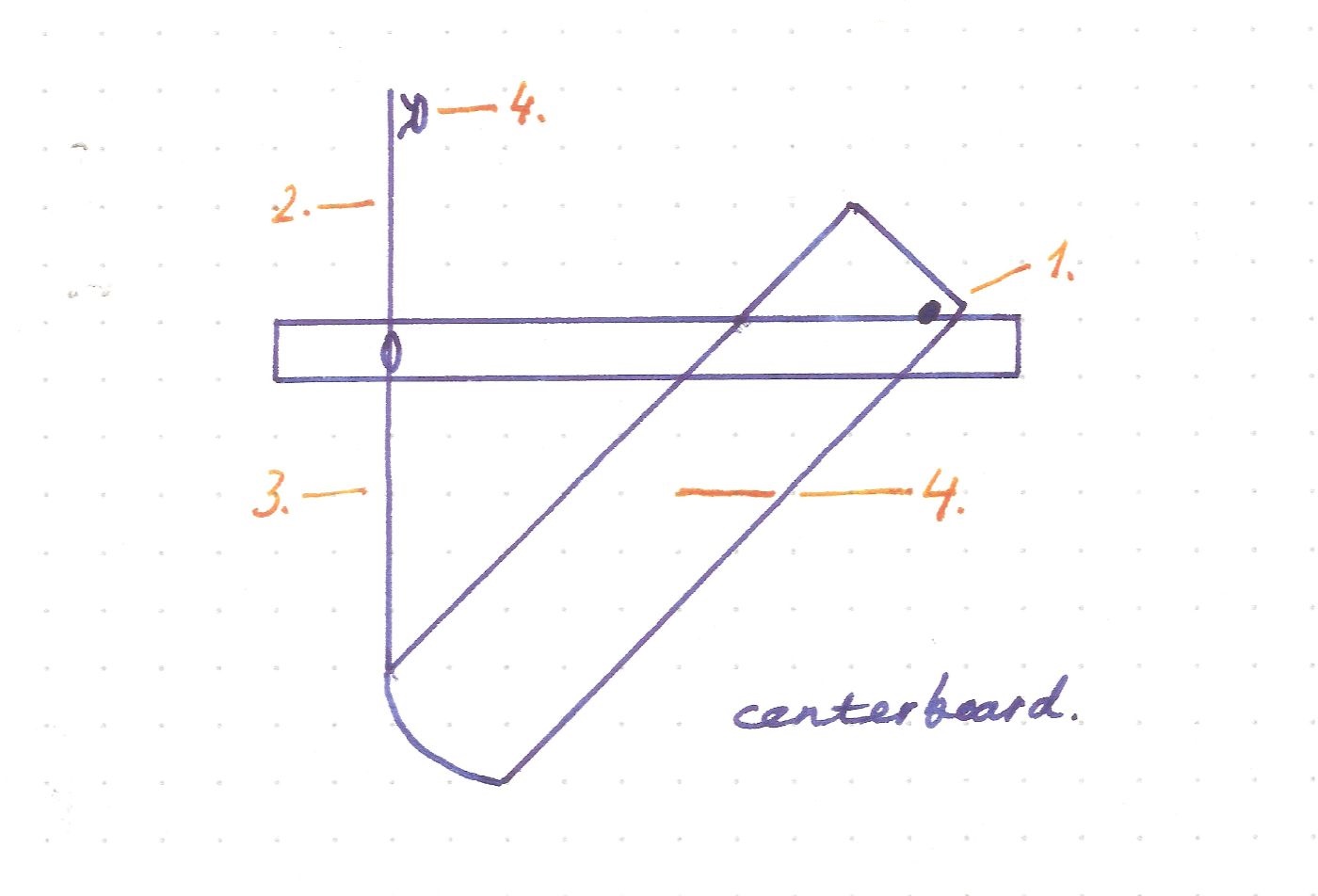
Heavier swing keels will generally be supported by hydraulics, so that design is a bit more complex.
The weighted swing keel consists of:
- grounding plate
- hydraulic ram
- lifting pennant
- retractable weighted fin
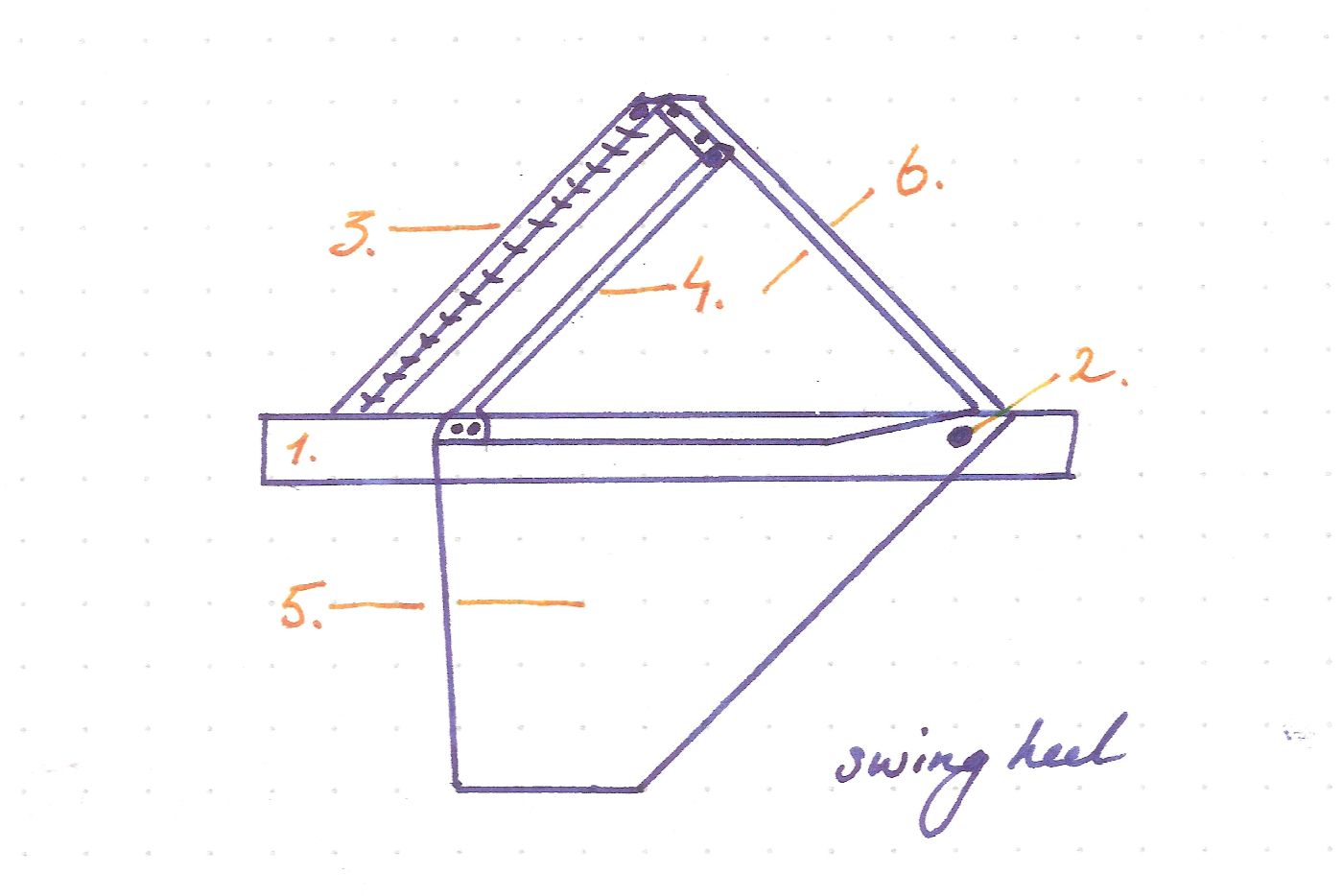
The keel has an eye bolt on its top aft, which attaches to a steel cable. The steel cable runs up through the hull and generally attaches to a
Since you can lower and lift the keel, you can determine the amount of wetted surface yourself. This will allow you to make your boat faster, more agile, or more directionally stable as you see fit.
If the weather turns, and you find yourself in a storm, simply lower it and be on your way.
I've really enjoyed the flexibility of this setup sailing the Frisian lakes and IJsselmeer, where water depth greatly varies, and there are a lot of shallows.
Another great benefit is your keel will lift up when you run aground head-on. This reduces impact damage and may make the difference between having a lifting keel and a dangling keel.
Swing keels provide great upwind performance thanks to a much smaller wetted surface, compared to, for example, full keels.
The variable draft allows you to dock and moor in alternative places other boats can't reach. It also allows you to get really close to shore or even beach her comfortably (with centerboards that retract all the way).
Also, when you do run aground, it is way easier to free yourself since you can simply lift the keel and be on your way.
However, there are also advantages to fixed keels over swing keels. Matej's compared the centerboard and swing keel to fixed keels in-depth and goes over all the pros and cons here.
The main setback with swing keels is that they require a lot more maintenance than fixed keels. There are a lot of moving parts involved, and each of these can be a liability when in bad condition.
It is critical to check each crucial part regularly. Some owners' manuals ask you to check the keel bolts before every sail. I'll go into the maintenance points of swing keels below.
The most important liabilities are your cable, pivot bolts, and eye bolt on the keel. Swing keel cables can simply break off, and with a weighted keel, this can result in you leaving your keel at the bottom of the ocean.
Your hinge can get stiff or develop some play, which may result in noise and rattling.
With swing keels, you'll need to perform regular maintenance with the lifting mechanism. This includes the lifting cable, pennant, and hydraulic levels of the hinge.
You need to check the tension of the keel hinge bolts before each sail to be sure.
You also need to maintain the lifting winch (if you have one). The Cornish Crabber I've sailed just used a simple line on a cleat in the kitchen.
Things you'll need to maintain:
- fastening the keel hinge bolts
- the lifting cable
- the lifting winch
- the eye bolt
- the pennant
- hydraulic levels of the hinge
- the turning ball
Here's a very good article on swing keel maintenance at stingysailor.com (new tab ).
- Cornish Crabber
- Catalina 22
- Catalina 25
- Southerly 49
- Southerly 95
- Benneteau Oceanis 331
- Jeanneau Sun Odyssey 292
- Jeanneau Sun Odyssey 32
If you want more information on these models , you can read a more detailed discussion on popular sailboat models with lifting keels here .
If you're interested in sailboats with lifting keels that are also trailerable , please check out our list of the most popular trailerable lifting keel sailboats .
There are dozens of keel types out there and all serve a different purpose and excel under different conditions. To understand which keel type is best for your situation , I recommend you read our Illustrated Guide to Sailboat Keel Types , which contains the fundamentals of keel design and an overview for each keel type's characteristics (including diagrams). It will help you understand which keel designs to consider in ten minutes or less.
sandra olson
i am going to pick up my first boat, it is a 22 ft, catalina, with a swing keel It is in someone’s back yard, he is not able to use it anymore, so he is giving it to me, I will have to learn all about this boat, on my own, so i am a little nervous, but looking forward to this adventure, It is a concrete bottom boat, as far as i know, I will know more after tomorrow, Your site has been helpful, I understand she comes with some sails, i may need one or two extra and has no motor, but is sitting on its own trailor, More tomorrow
Robert Trimmer
I am more of a powerboat person but I have been given a Snapdragon 23 yacht and it has a lifting keel, thank you for the insight on how they work as I will be taking it out before the end of the summer hopefully, I am a novice but will be undertaking training with experienced friends, also I will be obtaining an outboard motor as her engine currently does not work so I can use her on rivers, Your site has been very helpful, thank you.
Can you address one issue I am really interested in?
Does a lifting keel need to be all up or all down, or can you choose the level of depth depending on sailing conditions.
I live and sail in the Cayman Islands, an area where we have plenty of shallow water, but variable depth across a lagoon. It would be very useful to be able sail a boat with the lifting keel say half way down, rather than fully extended. Is this possible.
Also, can you sail downwind under spinnaker with the keel drawn up to reduced wetted area and increase speed?
Leave a comment
You may also like, centerboard (swing keel) vs. fixed keel: pros and cons.
Picking the right sailboat keel takes some understanding of the pros and cons of each. To help you out, I'll list the pros and cons of fixed vs. swing keels on …
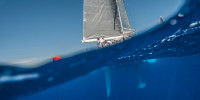
Sailboat Keel Types: Illustrated Guide (Bilge, Fin, Full)

What's the Best Keel Design for Bluewater Sailing?
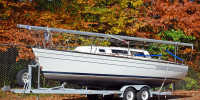
13 Popular Trailerable Sailboats with Lifting Keels
- New Sailboats
- Sailboats 21-30ft
- Sailboats 31-35ft
- Sailboats 36-40ft
- Sailboats Over 40ft
- Sailboats Under 21feet
- used_sailboats
- Apps and Computer Programs
- Communications
- Fishfinders
- Handheld Electronics
- Plotters MFDS Rradar
- Wind, Speed & Depth Instruments
- Anchoring Mooring
- Running Rigging
- Sails Canvas
- Standing Rigging
- Diesel Engines
- Off Grid Energy
- Cleaning Waxing
- DIY Projects
- Repair, Tools & Materials
- Spare Parts
- Tools & Gadgets
- Cabin Comfort
- Ventilation
- Footwear Apparel
- Foul Weather Gear
- Mailport & PS Advisor
- Inside Practical Sailor Blog
- Activate My Web Access
- Reset Password
- Customer Service

- Free Newsletter

Dufour 44 Used Boat Review
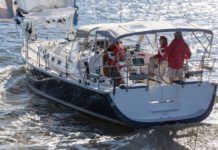
Blue Jacket 40 Used Boat Review

Catalina 270 vs. The Beneteau First 265 Used Boat Match-Up

Ericson 41 Used Boat Review

How to Create a Bullet-Proof VHF/SSB Backup

Tips From A First “Sail” on the ICW

Tillerpilot Tips and Safety Cautions

Best Crimpers and Strippers for Fixing Marine Electrical Connectors
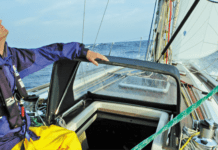
Solving the Dodger Dilemma

Polyester vs. Nylon Rode

Getting the Most Out of Older Sails

How (Not) to Tie Your Boat to a Dock

Fuel Lift Pump: Easy DIY Diesel Fuel System Diagnostic and Repair

Ensuring Safe Shorepower

Sinking? Check Your Stuffing Box
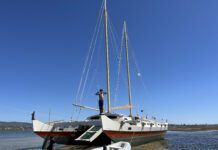
Why Choose the Wharram Design?
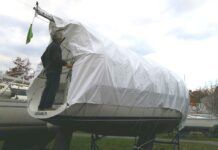
Winterizing: Make It Easy With Checklists

Boat Improvements for the Technically Illiterate

What Do You Do With Old Fiberglass Boats?

Stopping Holding-tank Odors

Giving Bugs the Big Goodbye

Galley Gadgets for the Cruising Sailor

The Rain Catcher’s Guide

Sailing Gear for Kids

What’s the Best Sunscreen?

UV Clothing: Is It Worth the Hype?

Preparing Yourself for Solo Sailing

R. Tucker Thompson Tall Ship Youth Voyage

On Watch: This 60-Year-Old Hinckley Pilot 35 is Also a Working…

On Watch: America’s Cup

On Watch: All Eyes on Europe Sail Racing

Dear Readers
- Inside Practical Sailor
A Short List of Centerboard Cruising Boats
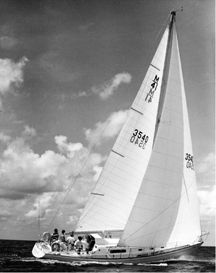
Being stuck on the west coast of Florida, with two shoaling channels offering the easiest access out to the Gulf of Mexico, Ive suddenly become more interested in centerboard cruisers. Generally, Im not a huge proponent of adding moving parts to a cruising sailboat, but the attraction of being able to make reasonable progress to windward, feel secure in a blow, and explore skinny-water paradises that are off limits to conventional offshore designs is hard to resist.

So this week, I started a short list of 35- to 45-foot boats that looked interesting to me. Some Ive sailed on; some I havent. Practical Sailor has reviewed several of these boats. (Ive provided links to the reviews of boats we have looked at.) Id be interested in adding to this list and hearing thoughts from other owners of centerboard cruisers.
They are listed in no particular order.
1. Krogen 38. I grew up down the street from the Krogen family on Key Biscayne and had the chance to visit Jims design studio when I was just starting out as a reporter back in the 1980s. This is a pure cruising cutter that Krogen designed for himself. It has two bronze centerboards, one in front of the other, making it very easy to balance on long passages. Pros: This is a robust, three-cabin cruising boat with a loyal following. Cons: Cored hull and teak decks on boats of this age can be landmines. Are two centerboards double trouble? 2. Morgan 41 . Ive sailed on a couple of these sloops and like the way they look and sail. The boats heritage gives it a loyal following (a good thing to look for in any used boat). Pros: Storied design, with a good deck layout and comfortable motion. Cons: Finish quality varies greatly as many were owner-completed. Factory interior is pretty basic. 3. Tartan 37 . A classic Sparkman & Stephens design. Three different couples my wife, Theresa, and I cruised in company with in the Caribbean had Tartan 37s, and all of them were happy with the boat. Pros: A very popular dual-purpose classic with good bones. Cons: A bit pricey for the size and vintage, and not as spacious as contemporary 37-footers.
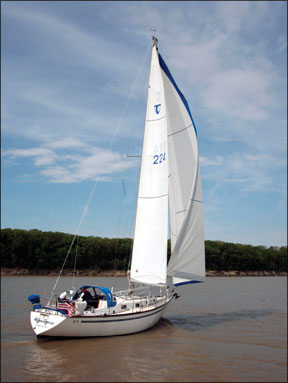
4. Ovni 43. In the Pacific and Southeast Asia, we sailed with two different couples cruising aboard these aluminum boats, made popular by circumnavigator, rally organizer, and author Jimmy Cornell. Pros: Tough aluminum construction, good track record. Cons: High price, and used boats are hard to find. 5. Block Island 40. Ive never sailed on this fabled yawl designed by Bill Tripp, but PS Technical Editor Ralph Naranjo often cites it as an example of rugged construction. Pros: Proven offshore design with a cult-like following. Cons: Many of the older Block Island 40s require expensive upgrades that will quickly eat through a cruising budget. 6. Bristol 35.5 . This Ted Hood design marked Bristols push into the big-boat market under Bristols boss Clint Pearson. Pros: This is a solidly built and popular Bermuda veteran. Cons: Totally enclosed cable makes it difficult to service. Not as spacious as contemporary cruisers in this size. 7. Sabre 38 MkI or MkII. Ive sailed several Sabres, ranging from the older Roger Hewson designed 34s to the new-generation Jim Taylor boats , and have always been impressed with the way they handled. Pros: Sabres craftsmanship is generally above average for production boats. Stick-built interior is more amenable to owner conversions. Cons: Outside of the Northeast, Sabres do not carry as much value as some other brands.
I initially thought Id dig up 10 boats, but with Thanksgiving around the corner, the crush of work and family obligations, Im calling this project to a halt for now. Happy Thanksgiving! Id love to hear some other suggestions to help round out the list!
RELATED ARTICLES MORE FROM AUTHOR
On watch: this 60-year-old hinckley pilot 35 is also a working girl.
Hood Gulfstar 40
LEAVE A REPLY Cancel reply
Log in to leave a comment
Latest Videos
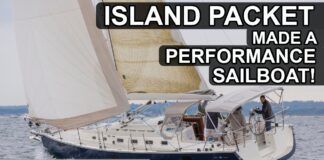
The Performance Sailboat from Island Packet: Blue Jacket 40 Boat Review

Top 3 Winter Boat HACKS!

Cabo Rico 34 Boat Review

Super Shallow Draft Sailboat: The Leeboard Sharpie
Latest sailboat review.
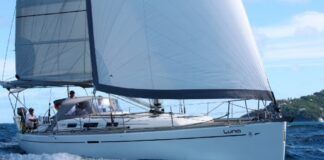
- Privacy Policy
- Do Not Sell My Personal Information
- Online Account Activation
- Privacy Manager
Visit our Popular Forums
- Monohull Sailboats
- Multihull Sailboats
- Powered Boats
- General Sailing
- Antares Yachts
- Fountaine Pajot
- Lagoon Catamarans
Cruising Business
- Boat Classifieds
- General Classifieds
- Crew Positions
- Commercial Posts
- Vendor Spotlight
Life Aboard a Boat
- Provisioning: Food & Drink
- Families, Kids, & Pets Afloat
- Recreation, Entertainment, & Fun
- Boat Ownership & Making a Living
- Liveaboard's Forum
Seamanship, Navigation & Boat Handling
- Seamanship & Boat Handling
- Training, Licensing, & Certification
- Health, Safety, & Related Gear
- Rules of the Road, Regulations, & Red Tape
Engineering & Systems
- Const. / Maint. / Refit
- Product / Service Reviews
- Electronics: Comms / AV
- Electrical: Batts / Gen / Solar
- Lithium Power Systems
- Engines & Propulsion
- Propellers & Drive Systems
- Plumbing / Fixtures
- Deck Hdw: Rigging / Sails
- Aux. Equipment & Dinghy
- Anchoring & Mooring
Photo Categories
- Member Galleries
- Life Onboard
- Sailing in the Wind
- Power Boats
- Cruising Destinations
- Maint. & Boat Building
- Marine Life
- Scuba Diving & Divers
- General Photos
Recent Photos

Listing Categories
- African Cats
- view more »
- Crew Wanted
- Crew Available
- Enhance Your Account
- Meet the Mods
- Meet the Advisors
- Signup for The Daily Cruiser Email


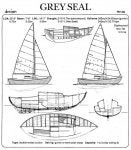

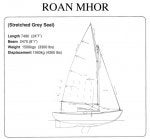
IMAGES
VIDEO
COMMENTS
Picking the right sailboat keel takes some understanding of the pros and cons of each. To help you out, I'll list the pros and cons of fixed vs. swing keels on sailboats in this article. ... An example of a typical centerboard would be a keel you see on small sailing dinghies - a board that goes into a slit in the hull's bottom and can be taken ...
The keel types that are known for their comfort and seaworthiness are full keel, bilge keel, wing keel, Scheel keel, and fixed keel. The best keel types for speed are canting keel, bulb keel, and wing keel. For improved maneuverability and agility, the best keel types are swing keel, centerboard keel, and daggerboard keel.
This article will help you choose which is best for your needs. As only a very general rule, most sailboats over 20-something feet have fixed keels. Most sailboats under 15 feet or so have centerboards. But there is a wide range of boats from 12 to about 25 feet with either a fixed keel or a centerboard. For example, in this photo, the boat on ...
A centerboard is a retractable appendage that pivots in and out of a slot (centerboard trunk) in the hull/keel of a sailboat. Having the ability to raise and lower the centerboard allows the the boat to operate in shallow waters when lifted, while maintaining good upwind sailing characteristics with the centerboard down.
Swing keels are the most versatile keels available, but it comes at a cost. Let's discuss those costs. I'll also show you two technical diagrams to explain t...
The most common sailboat keel types are full-length keels, fin keels, bulb keels, wing keels, bilge keels, and lifting keels. Full keels are popular among cruisers, while fin keels are generally used for racing. ... A centerboard is a type of retractable keel that rests on a hinge and can be lowered through a slot in the hull. It folds out like ...
First, and perhaps most importantly, a swing keel is not a centerboard. The two may look similar, but their likeness ends there. Centerboards are extremely common on small sailboats, especially trailerable sailboats. A centerboard sailboat has a flat bottom and a simple board that pivots back into the hull.
Ease the main or lower the traveler. Reef the main and the headsail in balance. When sailing off the wind, it is often better to reef the main before the jib, to help keep her head down. Rake the mast to spec. Sail the boat flat. Bear away in the puffs when sailing deep, before the boat begins to heel excessively.
A sailboat centerboard is a retractable fin that protrudes from the bottom of the hull. The centerboard keeps the boat stable and on course. Centerboards are an important and often overlooked part of a sailboat, but they're essential to stability and effective navigation. Centerboards perform the function of a keel and keep the boat on course ...
A sailboat centerboard is a retractable keel or fin located in the center of the boat's hull. It provides stability by counteracting lateral forces from wind, allowing the vessel to sail closer to the wind. The centerboard can be raised or lowered based on water depth and sailing conditions, optimizing performance and preventing damage.
Centerboard sailboats are vessels equipped with a retractable keel, called the centerboard, which improves stability and prevents drifting. These boats are highly versatile, allowing navigation in shallow waters by raising the centerboard or deeper waters when lowered. This design is commonly found in small to mid-sized sailing craft.
Dec 12, 2010. #5. Just to clarify, there are 3 different keel types being mentioned here, keel centerboard, fin or deep keel and full keel. The full keel has pretty much gone the way of the square rigger. A long (almost the length of the boat) keel with moderate draft. Its advantage is very straight tracking.
In the case of the Seward 46RK, the daggerboard, or lifting keel, is comprised of a solid polyester composite, with a fiberglass skin and a series of stainless rods running the length of the foil to both increase stiffness and carry a 7,500lb cast-lead ballast bulb. An electric motor, operated by a set of buttons at the mast, raises and lowers ...
A swing keel, also called a lifting keel, is a type of sailboat fin that can be retracted through a slot in the hull, which reduces draft and allows swing keel sailboats to navigate shallow waters like rivers. The keel rests on a frontal hinge and is generally lowered using a hydraulic ram. Having a swing keel has some unexpected advantages ...
Ive sailed on a couple of these sloops and like the way they look and sail. The boats heritage gives it a loyal following (a good thing to look for in any used boat). Pros: Storied design, with a good deck layout and comfortable motion. Cons: Finish quality varies greatly as many were owner-completed. Factory interior is pretty basic. 3. Tartan ...
To the questions you ask there is only one easy answer: Twin keels go to ground best, but do almost nothing else better than the same boat with a "regular" keel. To everything else any honest answer has "it depends". If you do not have restrictions on minimum draft, then a fixed keel will do better than a centerboard under most all conditions ...
Short answer daggerboard vs centerboard: A daggerboard is a retractable keel that can be raised or lowered vertically, providing stability and reducing sideways drift. On the other hand, a centerboard is also a retractable keel but pivots horizontally instead of vertically. While both serve similar purposes, their designs and mechanisms differ in terms of usage
I would choose the centerboard boat. I like the ability to get into shallow water to anchor and even sail through. If the boat is intended to be trailerable then all the more the centerboard draft for increasing places you can haul and launch. Ratings of the same boat with shoal vs deep keels allow about 3 to 5 seconds per mile.
There is a hugh difference between a 27 foot keel boat and a 14 foot centerboard boat. The 14' cb will respond much quicker to changes in the wind, chop in the water and the helm. Since the 14" cb is lighter than a 27 foot boat its just more responsive to changes in the position of crew weight and crew weight itself.